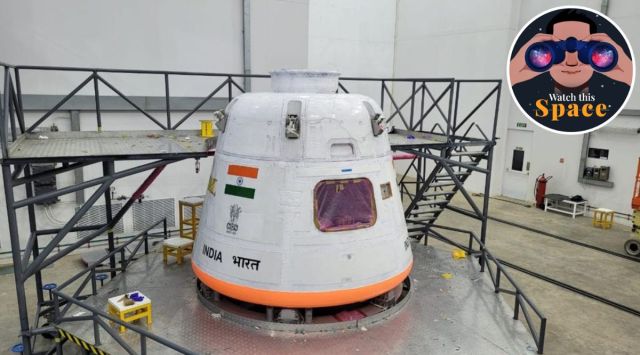Watch this space: Night for Chandrayaan-3, new dawn for Gaganyaan
As the Chandrayaan-3 mission drifts off into sleep, Sethu Pradeep writes about ISRO's Gaganyaan mission and what the space agency will need to develop for it.
 An unpressurised version of the crew module for ISRO's Gaganyaan mission. (ISRO via X.com)
An unpressurised version of the crew module for ISRO's Gaganyaan mission. (ISRO via X.com) It has been all but confirmed—the Indian Space Research Organisation’s Chandrayaan-3 mission is not going to wake up again. But as the sun sets on the mission’s Vikram lander and Pragyan rover again, a new era of human space flight could be dawning for ISRO as it is set to conduct the first flight test of the Gaganyaan mission.
Chandrayaan-3 was designed to last for one lunar day or about 14 days on Earth. After it finished its science objectives, scientists put it in “sleep mode,” hoping that the lander and rover could be reawakened after the lunar night. But now, it seems clear that the extreme temperature and conditions of the lunar night mean that the mission will sleep forever.
Despite that small disappointment, it is important to remember that the Chandrayaan-3 mission was a complete success, having demonstrated India’s capacity to soft-land a spacecraft on the Moon. As of now, there have only been four countries to achieve this feat—the United States, the erstwhile Soviet Union, China, and now, India.
Off the success of the Chandrayaan-3 mission and shortly after the launch of the Aditya-L1 mission, ISRO is now preparing to conduct the first flight test for what will be its first crewed mission.
Gaganyaan mission
The Indian space agency on Saturday said that it is preparing for the Flight Test Vehicle Abort Mission-1, (TV-D1), which is an uncrewed flight test for the Gaganyaan mission that will demonstrate the performance of its Crew Escape System.
The Gaganyaan mission’s crew module will be where the astronauts will be staying during the mission with pressurised Earth-like conditions. But TV-D1 will be testing an unpressurised version of the crew module that is now ready to be shipped to the launch complex. The unpressurised version has the same overall size and mass as the actual module, and it houses all the same systems for deceleration and recovery.
It has a complete set of parachutes and has recovery aids, actuation systems, and pyros. The avionics systems in the crew modules are in a “dual redundant mode” configuration to provide navigation, sequencing telemetry, instrumentation and power. At the end of the mission, this crew module will touch down in the Bay of Bengal, and it will recovered by the Indian Navy using a dedicated vessel and diving team.
With the Gaganyaan mission, ISRO hopes to demonstrate its human spaceflight capabilities by launching three astronauts to a 400-kilometre orbit for a period of three days and then bringing them back safely to Earth. Currently, the United States, Russia and China are the only three countries with the capability to launch public human space missions. Of course, there are also private companies like SpaceX that have already proven their crewed mission launch capabilities.
For the Gaganyaan mission to succeed, ISRO has to develop many technologies that will be critical to the mission. This includes the human-rated launch vehicle, life support systems, and emergency escape provisions for the crew. The space agency will also need to work on many auxiliary aspects like the training, recovery and rehabilitation of the crew.
Human-rated LVM3
The Launch Vehicle Mark-III (LVM3), earlier known as the GSLV Mk-III, is ISRO’s most powerful launch vehicle and has a proven track record. But for Gaganyaan, the launch vehicle will need to be reconfigured to meet human-rating requirements. The HLVM3 (Human Rated LVM3) will have a crew escape system powered by solid motors. In case of an emergency, either at the launch pad or during ascent, this escape system can take the crew module to a safe distance.
Gaganyaan’s Orbital Module
The Orbital Module of the mission, the spacecraft that will be orbiting the planet, will consist of a crew module and a service module. We already know that the crew module will provide a pressurised and habitable Earth-like environment for astronauts. The service module will be an unpressurised structure that will hold thermal, propulsion, power, avionics systems and deployment mechanisms.
Astronaut training for Gaganyaan
The space agency has established an Astronaut Training Facility in Bengaluru for classroom training, physical fitness training, simulator training and flight suit training. The sessions will cover academic courses and knowledge about the mission’s flight systems. Astronauts will be familiarised with micro-gravity environments through Parabolic flights. They will also master aer-medical training as well as recovery and survival training.







